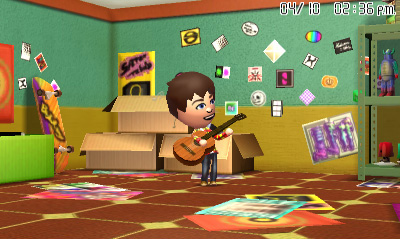Unique premise; Mii interactions are genuinely hilarious; island activities, including rap battles and stage performances; voice synthesizer.
Not for all tastes; a touch directionless; too dependent on Mii cultivation.
Weird. That is the number one word that comes to mind every time I think about Tomodachi Life. It’s a weird game, with no real goals and minimal direction, yet it’s also irresistibly charming. Like Animal Crossing, Tomodachi Life invites players into a virtual world to call home. What separates Tomodachi from Animal Crossing, however, is that rather than stuff the game world with anthropomorphic animals and tree shaking, it instead strives to be a surreal snippet of the real world. Using Miis, Tomodachi encourages the player to populate the game with Miis of friends, family, and celebrities, who in turn partake in oddball antics of all sorts. Watching the Miis interact and mingle is at the core of the experience, and what makes Tomodachi so endearing.
Tomodachi Life starts off just like the Move-in Version, with players asked to name their island city and create a personal Mii. From there, the Mii moves into its own apartment on the island (called, fittingly enough, Mii Apartments!), and the madness begins. Players must either create new Miis in the game or import them from the 3DS Mii Maker. Doing so fills up the apartment building, which in turn gives the Miis more friends to make and interact with. I found this one part of the game design a little hit or miss, in that for creative players it’s a breeze to concoct new Miis, whereas others who aren’t so inclined to make the avatars might have a harder time bolstering their population. Game progression is tethered to having multiple Miis, which also complicates the dilemma. It’s possible to snag Miis via QR codes, but it’s not a perfect solution.
In any event, the core experience of Tomodachi Life comes from placating the needs and desires of the Miis. They get hungry, want new clothes, want new apartment interiors, and much more. While that might make them sound like a bunch of needy crybabies, the reality is much more fun. Resolving the various issues of the Miis is very simple and fast. When they want food, a quick run to the market is all that’s required. New duds means a stop to the clothing store, and so on. Part of this activity revolves around guessing what particular item will or won’t please a given Mii, and watching each of their reactions is priceless. I gave my Mii version of Link a bowl of ramen, and he shot into the sky like a rocket, filled with joy! The sheer variety of interactions and responses is mind-boggling.

All of this item-fetching isn’t for nothing, though. Tomodachi Life’s activities revolve around a currency system, and the only way to make any money is via the Miis. Funds are dispensed generously, as giving a Mii food will often reward the player with more than it cost to feed them in the first place. Players can even get cash for doing nothing more than “peeking” into the mind of a Mii and seeing what they’re thinking about (remember I said this game is weird?). I never had to worry about having enough funds to participate in daily tasks, so I was free to focus on just having fun. Considering how easy it is to make money, it might seem pointless to have currency at all, but it does a good job of corralling the player and helping mete out activities and character growth over an extended period.
Growth isn’t limited to Miis, however, as the entire island begins to open up the more the game is played. Different shops and venues become available, offering more activities and more things to purchase. The game is stuffed with things to do, but herein lies part of the problem I mentioned earlier, which is the necessity for Miis. The fewer Miis present, the harder it is to unlock everything. I had to start scrambling to come up with characters in order to experience everything. Admittedly, though, there is a lot more fun to be had watching a horde of Miis form bonds and relationships with each other, so I can see why Nintendo might have made the decision to be so forceful about it. By the way, the Miis can become friends, but they can also become romantically involved and have a kid! Tomodachi Life wants players to form a community, and ultimately the player will have a better experience if they build one.
Tomodachi Life isn’t going to make all players happy. It can be a touch directionless, and the oddities of the Miis isn’t universally appealing. In the end, though, this is the sort of game that open-minded players will love if they give it a chance. There is so much to do and see on a daily basis, it almost becomes compulsory to switch on the game and check in with the Miis. Not a lot of games have as much heart as Tomodachi Life, and I really hope that fans give it the shot it deserves. Before I finish here, I’d be remiss if I didn’t point out the wonderful in-game image sharing tool that let’s players spread the joy of their island for other players to see on social media sites like Facebook and Twitter. Also, be sure to head to Tomodachi Life’s official website to get QR codes for celebrity Miis to add to your apartments!




 ShareThis
ShareThis






